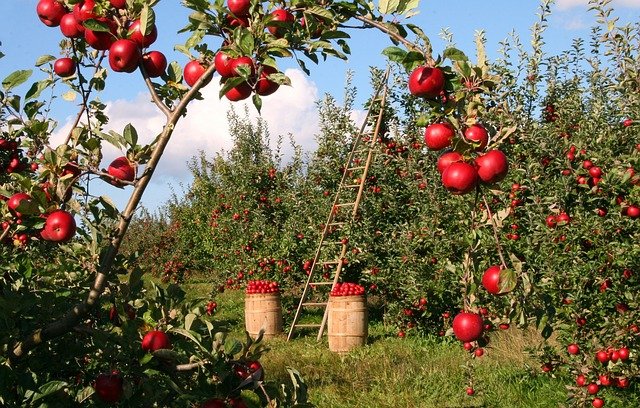How to plant and grow fruit trees
28th Jun 2021
There is something so satisfying about picking fruit from trees in your own garden. Bringing the crop into the kitchen and using your produce for homemade jams, chutneys, pies and all manner of baking.
Anyone can grow fruit trees in their garden or plot, no matter how much space you have. Even if you only have a patio, you can grow a single tree in a container. enjoy patio fruit trees or even cultivate a mini orchard if you have more space.
While most of us should be able to enjoy success planting and growing fruit trees the results can sometimes be frustrating.
I well remember the joy of seeing my first cherry tree full of blossom in spring only to endure the crushing disappointment of harvesting my ‘crop’ of exactly three small cherries in late summer.

Still, subsequent crops have been far more bountiful and most of us will enjoy great results from our fruit trees. And, to increase the odds of you bringing in a bumper harvest, I’ve put together a few great tips on how to plant and grow fruit trees.
Location, location, location
Positioning your trees is really important. They need plenty of sun so try and plant your trees or position their containers in as sunny a place as possible.
If you're planting more than one tree or already have other plants nearby do consider how tall the tree will grow and how wide the spread of each tree will be. Make sure each tree has plenty of growing room so it won't be fighting for sunlight as it matures.
Sign up for our newsletter and exclusive discounts
Also consider the soil if planting directly into the ground. Ideally the soil will retain moisture and be rich in nutrients. If you're planting in a container the quality of soil is of course much easier to control.
How to plant a fruit tree
If you're planting into the ground you're going to have to get down and dirty and dig a decent size hole. As a rough guide the hole needs to be twice as wide as the tree's roots or the container it came in. The hole should be equally as deep as the container.
After a good soaking of the roots the tree should be placed in the centre of the hole. It's important that the craft line of the tree is just above the level of the soil. Once the tree is in place the hole should be filled with a half and half mixture of soil and compost.
Once the tree is planted make sure you tramp down the soil around the roots to get rid of any air bubbles and give the tree another good watering.
The tree may need support so stake it well but don't make the ties too tight. The tree needs to be able to bend with the breeze.
Water well
As I’ve already mentioned the root ball of your new tree should be well watered before planting and once in the ground it should be given another watering.

Once planted you should make sure the tree is kept watered throughout the first year. Once established the watering regime can be cut back. To help promote growth, treat with fertiliser.
Pruning
The best of us will feel a little nervous about pruning. Like me you may be worried about cutting the tree back too much. But don't fret over it.
Fruit trees should be pruned to create space between branches. Overcrowding blocks the sunlight but pruning allows light to penetrate and also increases the circulation of air. This helps the fruit ripen and it can also reduce disease spreading through the tree.
Most fruit trees including apple and pear should be pruned in winter when the tree is dormant. Others such as cherry and peach trees are better pruned at the end of summer.
If the tree is cropping heavily, you can thin out the fruit so the branch doesn't snap under the weight.
Pollination
Pollinating fruit trees can put some people off planting their own. It seems complicated. But it's like most things - it's pretty straightforward when you get your head around it.
To bear fruit your trees have to be pollinated. Bees and birds are pollinators so you want to encourage them to visit your garden by planting shrubs which attracts them. Cross pollination happens when an insect or the wind transfers pollen from one tree to another. Which is why you need to plant more than one fruit tree.
However, there are self-pollinating fruit trees. These varieties don't need to be cross pollinated so can be grown on their own. In a pot on the patio for example.
You can learn more about pollination and other tips on growing fruit trees on our Ask the Expert pages.
Fruit trees fresh from the nursery
You can find your ideal fruit tree or fruit bushes such as raspberries by checking out the full range available from our Norfolk nursery by clicking here.


